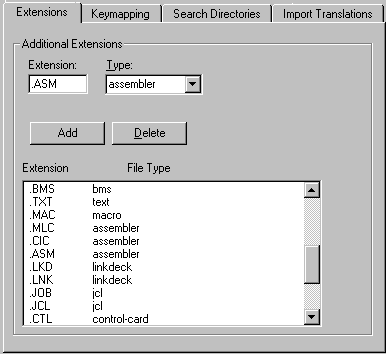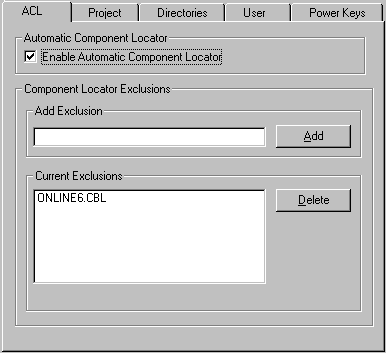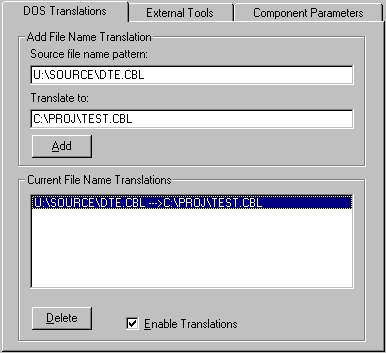

 | Browsing Your Project | SourceConnect Customization for Revolve |  |
This chapter describes the utilities that enable project and source file configuration.
The Utilities menu provides you with a variety of options for customizing the analysis environment, including:
The Options... menu item displays numerous tabs that enable you to set specific and general project options according to your analysis needs. This menu item is enabled for general environment settings prior to opening a project. When a project is opened, more tabs are available for project specific options.
Notice that if a project is shared, the options that are ADMIN exclusive are disabled to operators with USER access. For more information on shareable projects, refer to the section entitled Shareable Projects in the Managing Projects chapter.
The Extensions tab enables you to allocate a supported file type to an unrecognized extension. An extension is a three character string that is separated from the file name with a period and identifies the file's type. Revolve references the extensions defined in the Extensions tab when loading files by automatic typing. Automatic typing is performed when automatic is selected in the Add Component dialog's Type field. It signals to the parser that file extensions define file type. For example, when adding the component ONLINE1.CBL's extension is CBL. .CBL indicates that ONLINE1 is a COBOL file. The parser recognizes the extension .CBL as a COBOL file and loads it into the project accordingly.

Figure 7-1: The Extensions Tab
A list of file extensions and associated file types is displayed in the Extensions tab. Define new extensions or delete existing ones. New settings are applied to the current project only and will take effect the next time that you add components.
The Keymapping tab, enables you to create keyboard shortcuts for frequently performed operations in the Integrated Editor. Keymappings are very useful for customizing the editing environment. They make editing more efficient because common operations and functions are initiated from the keyboard, cutting down on mouse usage.

Figure 7-2: The Keymapping Tab
There are many common operations that are defined by default. They are displayed in the Current Mappings list. New mappings are assigned keystrokes and an action performed. Then they are added to the current mappings list and are immediately available for use in the Integrated Editor.
The Search Directories tab displays a list of directories used to search for system components and included files during the parsing process. A search directory is an accessible system directory that you identify because it contains components of a certain type that are referenced in project modules.

Figure 7-3: The Search Directories Tab
The Automatic Component Locator (ACL) uses search directories to locate and load referenced project components. For example, notice in the figure above, c:\revolve\sample\cobol\ is defined as a search directory for COBOL files. During the parsing process, a JCL references a file named BATCH1.CBL. When the parser encounters the reference, it deploys the Automatic Component Locator to the search directories defined for COBOL. If BATCH1.CBL is contained in c:\revolve\sample\cobol\ then it is loaded and parsed into the project. This functionality helps you automate some of the project creation process.
Though adding search directories with the Search Directories tab is a satisfactory method, it is preferred that you use the Add Components dialog and the Automatic Component Locator instead. For an example of adding search directories, refer to Creating and Loading Projects in the Getting Started book and see the section in this chapter on ACL.
In addition to accessing the Search Directories tab from the
Utilities > Options...menu, you can also access it from the Project
Manager with ![]() Options.... Note that the functionality of search directories settings
modified from the Project Manager apply to elements selected in the manager's
information window. This enables you to configure component level search
directory settings. See the section
Configuring At Component
Level in the chapter Managing Projects for more information.
Options.... Note that the functionality of search directories settings
modified from the Project Manager apply to elements selected in the manager's
information window. This enables you to configure component level search
directory settings. See the section
Configuring At Component
Level in the chapter Managing Projects for more information.
The Import Translations tab enables you to define file name translations for copybooks, proclibs, control cards, libraries, and other included files. Translating import names to supported standards is useful in some systems.

Figure 7-4: The Import Translations Dialog
During the initial setup of a project, you can spend a lot of time identifying relevant source code components in a system and downloading the correct files. The Automatic Component Locator or ACL makes this process easier and faster by:

Figure 7-5: The ACL Tab
Instead of having to individually add all source components to a project, you can specify a subset of modules (i.e. JCL job members, CICS tables, etc.) and let the Automatic Component Locator search for and load all of the required components. The ACL identifies references to components within the subset of modules and accesses defined search directories to locate and load components as they are referenced (i.e. COBOL, copybooks, procs, BMS, etc.). The ACL then recognizes references within the referenced components and loads the applicable files contained in defined search directories.
The ACL is enabled by default on the ACL tab. It works in conjunction with the Search Directories feature to locate directories containing necessary source components. If you want to use the ACL, you should set up search directories before adding components to a project. The best way to do this is to use the Add Components dialog. Select the directory that contains referenced source components. Set the Type to the type of the referenced components. Then click Add Search. When you add the subset of project modules, the search directory is used to load referenced components. For an example of adding search directories, refer to Creating and Loading Projects in the Getting Started book.
Not only is the functionality of the Automatic Component Locator useful when setting up a project but also in maintaining the project. When new components are added into a project during development, the Automatic Component Locator adds the new components and parses the new code. To start the loading process select Make on the Project menu or click Make on the Project Manager. Once the Make is complete, click Ok in the message box. The Automatic Component Locator only adds components referenced within the current project. That means that on line components not called by existing components in the project, such as MFS screens, may need to be added manually.
The Project tab enables you to configure your project by locating necessary modules on your local system. The fields contained in the Project tab are designed to configure your projects according to the following functionality.
Revolve enables the administrator to protect administrative access to a shareable project with a password. You are required to know the password every time administrative access to a project is requested.
The Directories tab is where you configure general Revolve directory parameters.
The User tab provides options for operator specific settings. It is here that you specify a USER ID for yourself that is used in shareable projects and other features like annotations. You can also change the font that is used to display information in tools and browsers. The following options can be used to customize the analysis environment and operator settings.
The keys F1 - F12 are assigned useful functions. With a single keystroke you can perform frequently used commands. The settings for the power keys are displayed in the Defined Power Keyslist.
The Power Key Definition window displays the definition of the selected power key and enables you to edit an existing definition or create a new one. Once you're satisfied with your power key definition, click Set to save it and make it accessible.
The DOS Translations tab enables you to map DOS drives, directories, and file names to other file names and directories. This feature is useful when a project has been built on a drive that appears to have different logical paths to different users. For example, if a project has been built on one user's workstation where the source files are located on a logical path beginning with U:\SOURCE\DTE.CBL and those same source files are stored on a second user's workstation on the logical path C:\PROJ\TEST.CBL then a file name translation can be used to map the original settings to the secondary user's parameters.

Figure 7-6: The DOS Translations Tab
Tools can be integrated into Revolve with the External Tools tab. Once a tool has been added into Revolve, it is invoked from the Tools menu or the speed menu. When you want to add a new tool, first type the name of the tool in the Tool edit box. Then enter the command line call to the tool by entering it in the Command edit box, or by clicking the Browse button and selecting an executable program.
Once the tool name and command-line options have been completed, click on the Add Tool button to add the tool. Note that if a new tool is being added with the same name as a tool already incorporated, the new tool replaces the older tool.
The command line can include the parameters for the file name, directory, line, and column of the selected element. These parameters are substituted into the following wildcards:
| Wildcard: |
Function: |
|---|---|
| %D | Specifies the directory of the source code file that contains the selected element. |
| %E | Specifies the extension of the source code file that contains the selected element. |
| %F | Specifies the path and name of the source code file that contains the selected element. |
| %N | Specifies the name of the source code file (with extension) that contains the selected element. |
| %S | Specifies the name of the source code file (no extension) that contains the selected element. |
| %X | Specifies the column in the source code where the selected element is located. |
| %Y | Specifies the line number in the source code where the selected element is located. |
To use these parameters, place {}'s around the portion of the command line that you want to be executed when an item is selected For example:
notepad.exe {%F}
If no item is selected when the tool is executed, then the command-line within the brackets is not executed. To modify any tools listed in the External Tools tab, click on the name of the tool in the Current Tools list. This enables you to modify the name or command line for the tool. When finished with the changes to the tool, click Add Tool to add it again. If you modified the name of the tool, a new tool will be created with the new name. If the tool name remains the same, the older tool will be replaced with your modifications.
To delete a tool from Revolve select the tool's name from the list and click Delete.
The Component Parameters tab contains options that determine how system files are handled in your project. These options serve as default settings for all components based on type as they are added to the current project. For example, all COBOL files that are added to the project are given parameters based on these settings. If you change COBOL settings, all COBOL files that are already loaded in the project are not affected. The new settings are applied to new COBOL files that you add to the project.

Figure 7-7: The Component Parameters Tab
The following parameters are available.
The term for the settings available in the Component Parameters tab is Project Level, because these options are applied to all components as they are added to the project. Sometimes it is useful to redefine parameters for components that have already been added to the project. Revolve facilitates this in the Project Manager. For more information see Configuring At Component Level.
The Tools/Views Options... tabs enable you to modify the default settings for various tools and views. Most views and tools that make use of an option dialog are represented here with a corresponding tab. The settings on these tabs are defaults and are used when tools and views are opened.
The Browser Options tabs enable you to modify the default settings for several browser Option dialogs. These settings are used when browsers are opened and implemented in analysis.
Copyright © 1999 MERANT International Limited. All rights reserved.
This document and the proprietary marks and names
used herein are protected by international law.
 | Browsing Your Project | SourceConnect Customization for Revolve |  |